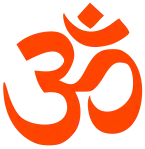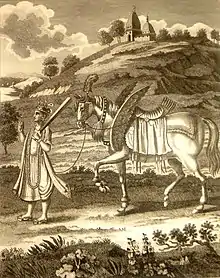Kalki Purana
The Sri Kalki Purana (Sanskrit: कल्कि पुराण Sri Kalki Purāṇa) is a prophesied work in Sanskrit that details the life and times of Kalki, the tenth and final Avatar of this earth. The narrative is set near the end of the Kali Yuga or Dark Age, as revealed by Suta.
| Part of a series on |
| Hinduism |
|---|
 |
|
The extant text comprises three aṃśas (sections) consisting 7, 7 and 21 chapters respectively.[1] Although it is considered an Upapurana or 'Secondary Purana', it is derived from passages taken directly from the 18 'Major' Puranas, including the Vishnu Purana and the Bhagavata Purana ascribed to Vyasa. The dating of the text ranges from 9th century to later centuries.[2][3]
Significance
As a prophesied work, the Kalki Purana writes details about events believed by Hindus to occur in the future. The work is essentially a derivation of passages collected from various Puranas describing the same subject. The work primarily describes the onset and exponential increase of evil and sin on the earth during the Kali Yuga, and the life of Kalki, who is said to bring an end to the darkness of the Kali Yuga, destroying evil and sin, and beginning a new yuga (age) of sinlessness and peace known as the Satya Yuga.
The text is a text of the Vaishnavism tradition in Hinduism, where Brahma and other gods approach Vishnu for protection from the evils of the Kali Yuga.[4] After listening to stories of persecution of his Dharmic Devotees, Vishnu promises to be born as Kalki in the family of Sumati and Vishnuyasha, in a village called Shambhala.[4] He studies the Vedas and other texts, then marries a princess named Padmavati of Simhala (Sri Lanka) kingdom. Kalki and his army then fight various wars and destroy all those who had persecuted and driven Dharma out of their land. After the annihilation of the evil and restoration of the good, Kalki returns to Shambhala. This marks the end of Kali Yuga, and the start of the new cycle of existence, with Satya Yuga. Kalki then returns to heaven, according to Kalki Purana.[4] The new cycle begins thereafter. The Puranas state that this era would be a union of spirituality and science. [4]
Kalki is also found in Buddhist texts, such as Kalachakra Tantra.[5][6] The Buddhist texts mention a king named Kalki from Shambhala who leads an army to destroy the Evil persecutors of dhamma; then after the victory of good over evil and attainment of religious freedoms, Kalki ushers in a new era.[7][8][9] The much later-era Buddhist text Vimalaprabha, which comments on Kalachakra Tantra, also mentions Kalki.[10]
Events Depicted in the Kalki Purana
Kali Yuga

Chronologically Krishna is described as the eighth Avatar of Lord Vishnu. This happens in Dvapara Yuga. When the first stage of the Kali Yuga begins, the varna system will deteriorate. Soon after this, the second, third, and fourth stages of the Kali Yuga begin. During the second and third portions, men will forget the name of God and no longer offer Yagna to the Devas. During the fourth portion, cannibalism will be virtually universal among the humans. To solve this problem the pious Devas will gather before Brahma for a solution. Near the end of this yuga, the Devas will then journey to Vaikunta to seek help from Lord Vishnu. Lord Vishnu will then descend to Earth to end the Kali Yuga.
Life on Earth
Sri Kalki will be an avatar of Lord Vishnu the supreme Parabrahman. He will marry his eternal consort Lakshmi who is the Heavenly mother. He will then undertake the mission to complete the end of Kali Yuga and rid the world of all wicked kings and false prophets, evil people and to usher in the age of Satya Yuga. Prophecies are said to be talking about Pralaya at the end of Kali Yuga.
Parashurama Avatar :- The Guru of Kalki Avatar
The Parashurama Avatar, which was the sixth Avatar of Lord Vishnu, according to this Purana, is predicted to be the Guru of Acharya (Teacher) of the Kalki Avatar, which is the Tenth Avatar of Lord Vishnu. In this Purana, Parashurama teaches the Vedas to the Kalki Avatar, so that he can develop a sense of morality and Dharma before his fight against evil. Parashurama also teaches the Dhanurveda to him so that he can fight off evil properly, and with correct techniques of warfare.
Destruction of Evil
One of the main reasons Lord Vishnu comes to earth as Kalki is to destroy and defeat evil forces on earth. He begins this with the battle, and eventual massacre, of the Sunyavadis, who have misled the people, at the city of Keekatpur. A war would later begin with Kali, including the demon generals Koka and Vikoka fighting against Kalki and the Devas. Thus, Kali will be defeated at the hands of Dharma, the personification of the Satya Yuga which is evil's polar opposite.[11]
Satya Yuga
After the defeat and destruction of evil on earth, the Satya Yuga dawns. Kalki will bring forth a golden age. Kalki will divide the earth into kingdoms among his generals. Sumati and Vishnuyasha, his parents, will then travel to the holy place of Badrikashram, where they will live. They have no death. They will go to Vaikuntha with Kalki. Having finished his mission of restoring peace, Kalki will rule.
Notes
- Rocher, Ludo (1986). "The Purāṇas". In Jan Gonda (ed.). A History of Indian Literature. Vol.II, Epics and Sanskrit religious literature, Fasc.3. Wiesbaden: Otto Harrassowitz Verlag. p. 183. ISBN 3-447-02522-0.
- The Tibet Journal, Volume 22. Library of Tibetan Works & Archives. 1997. p. 36.
Emil Abegg based on the reference to struggles between Visnuism and Buddhism, suggests that parts of the Kalki-Purana might date back to the 9th century
- Sarasvati Bhavana Granthamala, Vol. 103 (PDF). Sarasvati Bhavana Granthamala. 1972. pp. 3–12.
Then in all probability the Kalki-Purana may have been composed during the ninth and tenth century A.D
- Ludo Rocher (1986). The Purāṇas. Otto Harrassowitz Verlag. pp. 183 with footnotes. ISBN 978-3-447-02522-5.
- John Newman (2015). Donald S. Lopez Jr. (ed.). Buddhism in Practice: (Abridged Edition). Princeton University Press. p. 203.
- Sopa, Lhundub. The Wheel of Time: Kalachakra in Context. Sambhala. pp. 83–84 with note 4.
- Yijiu JIN (2017). Islam. BRILL Academic. pp. 49–52. ISBN 978-90-474-2800-8.
- [a] Björn Dahla (2006). Exercising Power: The Role of Religions in Concord and Conflict. Donner Institute for Research in Religious and Cultural History. pp. 90–91. ISBN 978-952-12-1811-8., Quote: "(...) the Shambala-bodhisattva-king [Cakravartin Kalkin] and his army will defeat and destroy the enemy army, the barbarian Muslim army and their religion, in a kind of Buddhist Armadgeddon. Thereafter Buddhism will prevail.";
[b] David Burton (2017). Buddhism: A Contemporary Philosophical Investigation. Taylor & Francis. p. 193. ISBN 978-1-351-83859-7.
[c] Johan Elverskog (2011). Anna Akasoy; et al. (eds.). Islam and Tibet: Interactions Along the Musk Routes. Ashgate Publishing. pp. 293–310. ISBN 978-0-7546-6956-2. - John Newman (2015). Donald S. Lopez Jr. (ed.). Buddhism in Practice (Abridged ed.). Princeton University Press. pp. 202–205.
- John Newman (1985). Geshe Lhundub Sopa (ed.). The Wheel of Time: Kalachakra in Context. Sambhala. pp. 56–78, 83–86 with notes.
- . Raja Shashidhwaja, a great devotee of Vishnu, has been granted a boon by Lord Vishnu of defeating Kalki on the battlefield.
Sources
- himanshu aneria, Kalki Purana, Fusion Books (1969) ISBN 81-288-0588-6
External links
| Wikimedia Commons has media related to Kalki. |